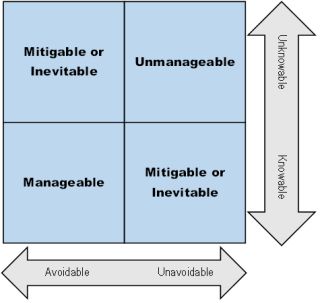Decision-Making
Navigating the Landscape of Unintended Consequences
Successful navigation often depends on how knowable and avoidable they are.
Posted July 8, 2024 Reviewed by Devon Frye
Key points
- Unintended consequences vary in how knowable and avoidable they are.
- These categorizations can be applied to the concepts of risk and uncertainty.
- We can take steps to reduce knowable and avoidable consequences.
- Resilience and flexibility can allow us to more effectively respond to the unknowable and unavoidable.

I don’t generally read articles focused on climate science or planetary systems. And I certainly don’t write about either of those topics, as both are outside my expertise.
Suckling et al. (2021), though, published an article in Frontiers in Climate that, at least conceptually, applies to human decision-making more generally. Their article was focused on unintended consequences, and most of us have made or been the recipient of decisions that produced such consequences.
Their framework (see Figure 1) poses implications for more than just climate science or planetary systems. By examining it, we can draw valuable lessons for managing risks and uncertainties in both personal and professional decision making. But there are three points worth mentioning.

First, what is knowable (i.e., capable of being known) is different than what we do, in fact, know [1]. For example, think about packing for a trip you’ll be taking the next day.
It is knowable what the weather is expected to be like at your destination during your travel dates because weather forecasts are available. However, if you don't check the forecast, you won't actually know what to expect or how to pack [2]. This distinction is important in decision-making, as there may be a gap between what can be known and what is actually known.
Second, there’s a fuzzy line between the avoidable and unavoidable. For example, consider traffic congestion during your daily commute. While it may seem unavoidable at times, there are often ways to avoid it, such as leaving earlier, taking a different route, or using public transportation.
However, even with these strategies, some level of congestion might still be inevitable due to unexpected events like accidents or road closures. This fuzzy line demonstrates how some factors can be managed to a degree but not entirely controlled.
Finally, the categories aren’t necessarily static. What might not be knowable today could very well be tomorrow as we gain new information, and what might seem like an unavoidable consequence of a decision might become more avoidable once we have greater experience in making that type of decision.
Knowable and Avoidable: The Manageable Risks
Consider the decision to implement a new software system in a business setting. Such a transition is laden with predictable challenges, including user resistance and technical glitches. These issues are knowable and, with proper foresight, avoidable. By conducting thorough training sessions and ensuring robust IT support, a company can mitigate these risks, at least to some degree.
Similarly, in our personal lives, we often face knowable and avoidable consequences. For instance, managing our finances effectively by creating a budget and tracking expenses is a decision with many predictable benefits and challenges. By planning ahead, setting clear financial goals, and seeking advice when needed, we can often avoid overspending. This proactive approach helps maintain financial stability and reduces the likelihood of encountering avoidable financial difficulties.
Knowable and Unavoidable: The Inevitable Outcomes
On the other hand, some consequences, while predictable, are unavoidable. Downsizing a company to cut costs is a classic example. The decision, though it may be necessary, inevitably leads to reduced morale and potential loss of institutional knowledge. Recognizing these outcomes allows for the development of strategies to manage the impact, such as offering counseling services and creating knowledge transfer programs to retain expertise.
In our personal decisions, we encounter similar scenarios. Choosing to pursue a demanding career path, for example, could lead to stress and reduced leisure time. These are knowable and unavoidable consequences. However, being aware of them allows us to develop coping strategies to mitigate their impact.
Unknowable and Avoidable: The Unexpected Risks
The realm of unknowable and avoidable consequences presents unique challenges. Launching a new product in the market can bring unforeseen risks, such as a competitor releasing a superior product. These risks are initially unknowable, but they can become avoidable with continuous market monitoring and adaptive strategies. This requires a flexible approach, where decision-makers are ready to pivot based on new information.
In our personal lives, planning a long-term travel adventure serves as a fitting example. The potential risks, such as changing political climates or unexpected health concerns, are unknowable at the planning stage.
However, by staying informed about global events and maintaining flexibility in travel plans, many of these risks can become manageable and avoidable as they arise. This adaptability ensures a safer and more enjoyable experience, highlighting the importance of staying prepared for the unexpected.
Unknowable and Unavoidable: The Pure Uncertainties
Finally, there are consequences that are both unknowable and unavoidable. These pure uncertainties are the most challenging to navigate. Sudden global supply chain disruptions, as seen during the COVID-19 pandemic, exemplify this category. These events cannot be predicted or avoided, emphasizing the need for resilience and adaptability. Building resilience through diversified suppliers and maintaining emergency inventories can help businesses weather such storms.
In personal decision making, unknowable and unavoidable consequences might include health crises or natural disasters. While we cannot predict or prevent these events, we can cultivate resilience through emergency preparedness and strong support networks.
Integrating the Framework with Risk and Uncertainty
The distinction between knowable and unknowable consequences and their avoidability closely aligns with the concepts of risk and uncertainty, a topic I have written on in the past (Grawitch, 2020). Risks are typically knowable and manageable through planning and foresight, while uncertainties are unknowable and require adaptive approaches. This integration offers a comprehensive view of decision-making, helping us navigate the complexities of both predictable and unforeseen outcomes.
Applying the Lessons in Daily Life
Understanding the nature of unintended consequences can significantly enhance our decision-making processes. Here are some practical steps to apply to everyday decision-making:
- Identify potential risks and benefits. Before making a decision, especially a high-stakes decision, list potential risks and benefits. Consider both immediate and long-term impacts.
- Take steps to reduce knowable and avoidable risks. This approach involves identifying potential challenges and implementing measures to reduce the likelihood they occur. By anticipating issues and preparing strategies to address them, you can mitigate negative outcomes and ensure smoother execution of your plans.
- Embrace flexibility. Remember that uncertainties can become risks as the unknowable becomes more knowable over time. As such, staying adaptable to new information and being ready to pivot as new information becomes available can help to reduce the likelihood of unknowable and avoidable consequences occurring over time.
- Build resilience. Prepare for unknowable and unavoidable consequences by building resilience. This includes maintaining emergency resources and cultivating support networks.
Conclusion
In summary, understanding the distinctions between knowable and unknowable and avoidable and unavoidable consequences provides a valuable framework for decision-making. By identifying potential risks and benefits, taking proactive steps to minimize knowable and avoidable risks, embracing flexibility to adapt to new information, and building resilience against unforeseeable challenges, we can navigate both personal and professional decisions more effectively.
This approach not only helps mitigate negative outcomes but also enhances our ability to manage uncertainty and complexity in a dynamic world.




